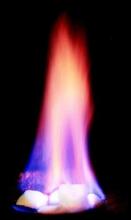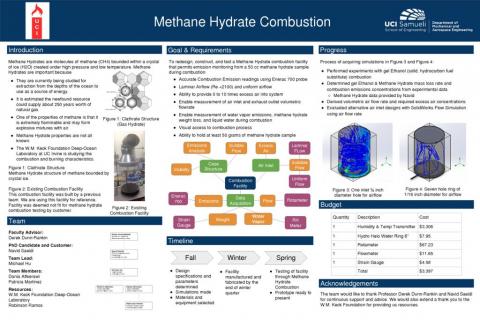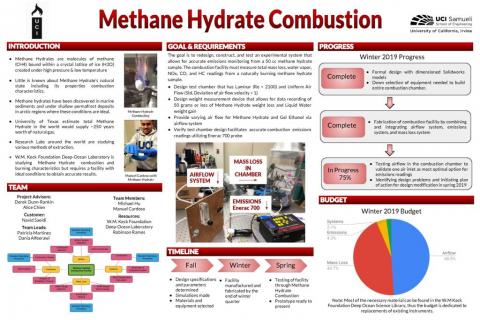Methane Hydrate Combustion
Background
Methane Hydrates are molecules of methane (CH4) bound within a crystal lattice of ice (H2O). The general formula for this gas hydrate (clathrate) is CH4*nH2O, where n represents the number of water molecules in the lattice structure. The nominal methane hydrate composition is CH4*5.75H2O.
Methane Hydrates are formed at high pressure and very low temperatures. Discoveries in the past decades have brought to light the existence of methane hydrates in marine sediments and under shallow permafrost deposits in arctic regions where these conditions are ideal. Since the discovery, they have been studied for extraction to use as a source of energy. According to the U.S. Department of Energy, it is estimated that the global methane hydrate resource is 20,000 trillion cubic meters which is about 700,000 trillion cubic feet (Tcf). The U.S. currently only has about 2,074 Tcf of methane hydrate resource. Researchers at the University of Texas estimate that given the current consumption rate in the United States alone, the newfound resource could supply about 250 years worth of gas. This makes the extraction of methane hydrates valuable.
However, although methane hydrates have great potential for resource, they also pose great potential for hazard. Despite being able to be created in laboratories, little is known about the characteristics and properties of the natural state. While researchers are studying extraction methods, the W.M. Keck Foundation Deep-Ocean Laboratory at UC Irvine is also focusing on studying the combustion and burning characteristics since methane hydrates are extremely combustible. The warming of hydrates releases methane that can hold a flame and evaporate the water and ice. With global warming serving as a method of warming the hydrates as well, it is necessary for the combustion properties to be known. Therefore, it is crucial to study different properties of methane hydrate as it is a huge potential for energy source, but also since it is a greenhouse gas, it possesses great danger if mishandled.
PhD, Navid Saeidi, is currently doing research on the possibility of extracting Methane Hydrate from the depths of the oceans and replacing it with CO. However, methane hydrates are sensitive sediments that have many unknown combustion and burning characteristics. The goal of the team is to design, build, and test a methane hydrate combustion facility for Navid to use in the study of emissions readings of methane hydrate during combustion. These readings include NOx, CO, and HC emissions from a naturally burning 50 cc methane hydrate.
Some design consideration for this project also include having laminar flow rate inside combustion facility as well as a water vapor measurement technique.
Goal and Objectives
The team’s objective is to optimize an existing methane hydrate combustion facility by redesigning, constructing, and testing the facility. The current issue is that the existing facility does not accurately measure emission readings designed for 50 cc Methane Hydrates using an Enerac 700 emissions measuring device. The readings have been determined to be inaccurate due to an uneven distributed airflow that causes turbulent airflow instead of laminar airflow. Additionally, the new facility should be able to measure total mass loss, liquid water evaporation, and NOx, CO, and HC emission from a naturally burning methane hydrate sample. This project is to be completed in two to three quarters with the start date in Fall 2018.
Contacts
Faculty Advisor(s):
Derek Dunn-Rankin – ddunnran@uci.edu
Student Contact(s):
Michael Hu - mlhu@uci.edu
Patricia Martinez - patrim2@uci.edu
Dania Alfeerawi - dalfeera@uci.edu
Manuel Cardoso - mcardos1@uci.edu



